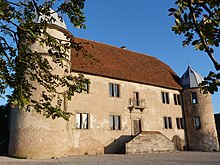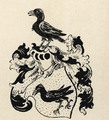Streiff from Lauenstein
Streiff von Lauenstein , historically also Straffer von Loewenstein, is the name of an extinct Palatinate noble family whose members were able to spread to Alsace , Brandenburg , Poland and Livonia .
history
The noble family comes from the Vosges and once lived in Löwenstein Castle . The castle was destroyed in 1386 by the city of Strasbourg and the Count of Lichtenberg. The robber barons Hennel Streiff and Johann von Alba are said to have been beheaded in Strasbourg afterwards.

Part of the family then lived in Pfalz-Zweibrücken , whose members held administrative offices in the counties of Saar Werden and Herbitzheim . In 1570, Count Johann IV von Nassau-Saarbrücken enfeoffed the family with a dairy farm in Diedendorf in Crooked Alsace - including permission to build a castle there. In 1599 the family was recognized as noble in Poland. In the Thirty Years' War , individual members of the family stood out in particular. The Swedish Lieutenant General Johann Streiff von Lauenstein († 1632) founded the branch in Livonia . His descendant Johann Heinrich Streiff von Lauenstein (1647–1700) was able to fill the post of Livonian land marshal there . But with him this branch was extinguished. Several sons of the family served as officers in the Swedish and French armies in the 17th century, including the later Brandenburg Major General Jean Reimbert (1610–1697) and Otto Eberhard († around 1646), both of whom came to Brandenburg in 1685. After Otto Eberhard's death, his widow Eva Johanna née Streif von Lauenstein returned with her children to their destroyed home at Diedendorf Castle. The last of the family, Charles Streiff von "Leuenstein" (1696–1754) died on December 28, 1754 in Lunéville. He was the son of Frédéric (1658–1706) and Thérèse Guyot, Jean Reimbert (1610–1697) was his grandfather.
Historical property
- in Livonia
- Alt-Calzenau , Fehteln, Odensee, Sanssen and Jummerdehn (until 1678)
- in Prussia
- Eygarren and Kamschen
- in Alsace
- Diedendorf
coat of arms
The family coat of arms shows a black and gray crow with red arms and a headstock in gold . On the helmet with black and gold covers the crow.
The crow also occurs sitting on a tree trunk, also seen again and with other tinctures .
Heraldic representations
Relatives
- Johann Streiff von Lauenstein († November 7, 1595), bailiff in Nassau-Saarbrücken , master of Diedendorf
- Philipp Streiff von Lauenstein († 1647), Privy Councilor of Count Palatine and Elector Karl Ludwig , Plenipotentiary Envoy to the General Peace Negotiations in Münster and Osnabrück, "Conseiller d'Estat du Prince Palatin et son Ambassadeur à Munster", friend of the French embassy member Théodore Godefroy
- Johann Streiff von Lauenstein († 1632), Swedish, then Kurbrandenburg colonel in the Thirty Years War
- Johann Heinrich Streiff von Lauenstein (born March 15, 1647 - † February 9, 1700), Swedish lieutenant colonel, then Livonian land marshal
- Hans Heinrich Streiff von Lauenstein, Swedish major general
- Johann (Jean Reimbert) von Streiff von Lauenstein (* 1610; † April 28, 1697) Kurbrandenburg colonel
literature
- Johann Friedrich Gauhe : Of salvation. Rom. Reichs Genealogisch-Historisches Adels-Lexicon. Part II, Leipzig 1747, p. 1117
- Maximilian Gritzner : J. Siebmacher's large and general book of arms , vol. 3., section 11., The nobility of the Russian Baltic provinces , Nuremberg, Tfl. 147
- Ernst Heinrich Kneschke : New general German nobility lexicon . Volume 9, Leipzig 1870, p. 84
- Leopold von Ledebur : Nobility Lexicon of the Prussian Monarchy . Volume 2, Berlin 1856, pp. 496-497
- Archives départementales du Bas-Rhin: Evangelical church records, Diemeringen, Diedendorf, Bouquenom, Lorentzen, Bouxwiller, Strasbourg.
Web links
- Johann Heinrich Streiff von Lauenstein family ( memento from September 30, 2009 in the Internet Archive ) in the Brotze collection
- histoire-locale-alsace (French)
Individual evidence
- ↑ Michael Frey, attempt of a geographical-historical-statistical description of the judicial district of Zweibrücken in the royal. Bayer. Rheinkkreis, dermalen Pfalz , p. 250, digitized
- ^ Rainer Babel: The Westphalian Peace Congress from a French perspective. A fragment of Nicolas Doulceur's diary from the years 1647/48 , In: Francia., Forschungsungen zur West European History, 16/2 (1989), pp. 13–28, here p. 18 note 21
- ↑ Bernd Warlich: The Thirty Years' War in personal reports, chronicles and reports. Volkach ( online version )
- ↑ Baltic Monthly , Volume 47, p. 181, Die Livländische Landmarschälle



